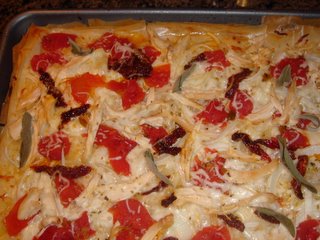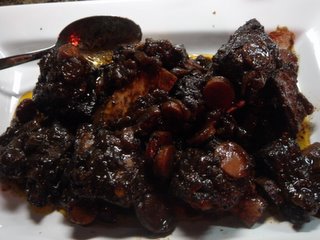 Dough making has always intimidated me. The challenge of coaxing little invisible organisms into aerating the flour mixture to the perfect puffiness and chewiness never failed to induce serious sweaty palms. Needless to say, sweaty palms are terrible for kneading. Normally, I am not one to shy away from a challenge. But on a Friday night when I’ve got a ravenous boyfriend on his way back from a long session at the gym, experimenting with dinner didn’t seem like the smartest idea. So what was a girl to do in a pinch? She reached for some phyllo.
Dough making has always intimidated me. The challenge of coaxing little invisible organisms into aerating the flour mixture to the perfect puffiness and chewiness never failed to induce serious sweaty palms. Needless to say, sweaty palms are terrible for kneading. Normally, I am not one to shy away from a challenge. But on a Friday night when I’ve got a ravenous boyfriend on his way back from a long session at the gym, experimenting with dinner didn’t seem like the smartest idea. So what was a girl to do in a pinch? She reached for some phyllo. The phyllo was intended for the shell of a fruit tart, which was to be made during the weekend. I imagined that the same techniques for making the tart shell would also work to make a base for a pizza. After all, butteriness and crispiness would be hard to resist in either sweet or savory incarnations. I did, however, conjure up an additional savory flare for the pizza base by sprinkling a good grated parmesano-regiano between the phyllo sheets, which introduced a nice depth of flavor.
The pizza toppings were a collage of staples from my pantry accompanied by one or two fresh ingredients from the fridge. On top a cushy bed of freshly shredded mozzarella, I added some torn up pieces of stewed tomatoes, which, in my opinion, were a hundred times brighter tasting than their mealy supermarket counterparts. Some sun-dried tomato pieces were scattered for additional acidic punches while a few fresh sage leaves provided some color. Pulled pieces from the previous night’s roast chicken were generously piled on as a final touch to please the man who is always asking “where is the meat”? It took a mere 30 minutes to assemble, bake, and get the pizza to the table. I even had a private moment to take a few sips from my glass of red before J whizzed in and bear-hugged me in his sweaty gym garb. Simple Phyllo Pizza 3T butter, melted 1. Preheat oven to 375°F. 2. Mix melted butter with olive oil and brush a 15x10x1 inch baking sheet with the mixture. 3. Cover the base of the baking sheet with one sheet of phyllo and brush the sheet with the butter and olive oil mixture. Sprinkle some grated Parmesano-regiano on top (making sure you have enough to sprinkle on each layer). 4. Repeat the above layering of phyllo, butter and oil mixture, and grated Parmesano-regiano until all the phyllo sheets have been used. 5. Place an even layer of mozzarella cheese on the top layer of phyllo and arrange the tomatoes, chicken pieces, and onion slices on top of the bed of mozzarella. 6. Sprinkle the pizza with oregano and thyme. 7. Bake pizza until the phyllo sheets are crisp and golden brown at the edges and the cheese has melted, about 15 minutes.
3T olive oil
10 sheets fresh phyllo pastry or frozen, thawed
¼ cup grated Parmesano-regiano
1 ½ cup of shredded mozzarella
1 14 oz can of stewed tomato, well drained and torn into chunks
1 ½ cups of roast chicken pieces (optional)
1 medium onion, sliced (optional)
1 teaspoon dried oregano
1/2 teaspoon dried thyme

